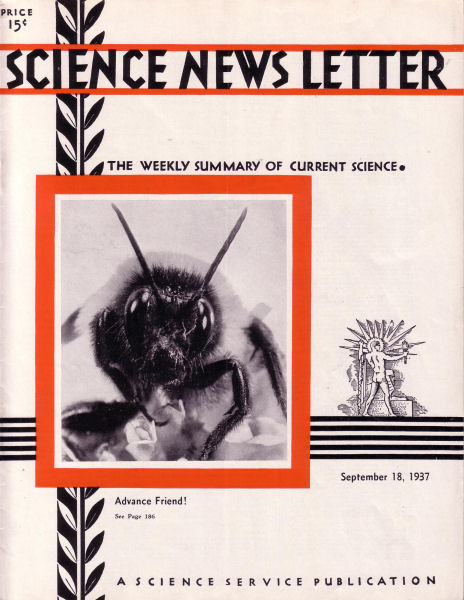From the September 18, 1937, issue

WITHOUT BENEFIT OF INSECTS
Drowsy Sunday afternoon. The hammock under the apple tree looks inviting. May be something worth reading in this magazine . . . Let’s see . . . Something here about bugs . . . mm . . .
You have half decided to take a little snooze instead of going on reading, when your ankle begins to itch: some adventurous mosquito has decided not to wait until dusk. Then a bumblebee zips by, doesn’t like something about you, zips back again, a couple of times. And an acrobatic caterpillar slides down a cable of his own making, to stop right on the place where your hair used to be.
Confound all insects anyway! Whatever were they invented for, the crawling, biting, stinging nuisances? World might be a place halfway fit to live in, if the whole lot of them could be wiped out.
And science says, at that, they may wipe us out instead. Well, let ’em. If there get to be many more of the cussed things about, the world won’t be fit to live in, anyway. The doggone pests!!
So you give up the hammock and go back to the safe fortification of the screened-in porch.
But would you be happy if all insects were wiped out? It’s even a question whether you would be there at all. For though some insects pester man and loot his granaries and warehouses, other insects perform a long list of services for him. So many services indeed that without the insects, existence for man and the larger animals would be difficult, if not impossible.
ANTI-BLOOD CLOTTING AGENT CLUE TO THROMBOSIS TREATMENT
Prevention of dreaded blood clots, the often fatal condition known medically as thrombosis, may now be nearer at hand. This appears from research reported by Dr. Edwin Chargaff of the College of Physicians and Surgeons, Columbia University, at the meeting of the American Chemical Society in Rochester, N.Y.
The mechanism of blood clotting is one of science’s still unsolved mysteries. Hemophilia, or bleeder’s disease, is one result of defect in this mechanism, and thrombosis is another.
By combining a small amount of sulfuric acid with a waxlike substance found in the brain, Dr. Chargaff obtained a substance that very markedly checks the clotting of blood, he reported at the meeting of the American Chemical Society. The material is called cerebroside sulfuric aid, and this is the first time it has been made in the laboratory.
Sulfuric acid is also found in heparin, the most powerful anti-blood-clotting substance known. It was originally discovered in the liver by Dr. W.H. Howell of the Johns Hopkins University. In purified form, heparin injections have prevented thrombosis formation to a considerable extent in animals, Drs. C.H. Best, Arthur Charles, and Campbell Cowan of the University of Toronto reported.
Study of the eventual practical application of Dr. Chargaff’s latest discovery is now under way.
EXPLOSIONS OF FIRECRACKERS MAKE FIREFLIES SHOW OFF
Fireflies can be stimulated into very greatly increased display of their animated “fireworks” by nearby explosions, Dr. Rudolf Ruedemann of the New York State Museum reports (Science, Sept. 4).
On the evening of July 4, Dr. Ruedemann states, he was looking out over his lawn, where about half-a-dozen fireflies were leisurely flashing. Some boys, who had been setting off ordinary small firecrackers, suddenly switched to the much noisier giant cannoncrackers. Instantly, the number of firefly flashes increased eight- or tenfold in number, the rate of flashing speeded up to more than double, and the insects kept down very close to the ground. As soon as the loud explosions stopped, the firefly display went dark, with the exception of three insects that rose into the shrubbery.
The flashing of the particular kind of firefly noted by Dr. Ruedemann is often considered to be a warning response to threatened danger—for these fireflies are refused as inedible by bats and other night predators. Dr. Ruedemann thinks that they may have given the characteristic danger reaction to the artificial stimulus of the cannoncracker explosion.







